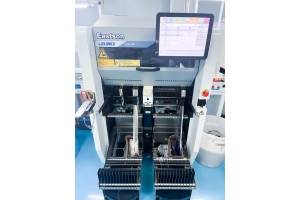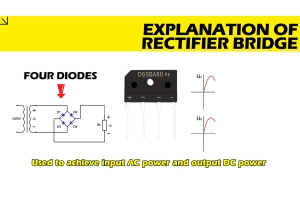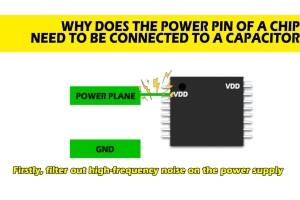Selecting the perfect transistor can be a daunting task, but fear not! We're here to provide you with a step-by-step breakdown of the factors to consider, ensuring you make an informed decision.
Whether you're a beginner or an experienced electronics enthusiast, this guide will equip you with the knowledge to navigate through the transistor selection process effortlessly.
What are Transistors?
Transistors are tiny electronic devices that play a big role in making our modern technology work. They are like the traffic controllers of electronic circuits, helping to control the flow of electricity.
Transistors are made from materials called semiconductors, such as silicon. Each transistor has three main parts: the emitter, the base, and the collector. These parts work together to control the flow of electricity through the transistor.
When a small current flows into the base of a transistor, it can either allow or block a larger current to flow between the emitter and the collector. This small current acts as a kind of switch, turning the transistor on or off. This switching action is what makes transistors so useful in electronic devices.
Transistors have revolutionized the world of electronics. Before their invention, bulky vacuum tubes were used, which were less efficient and consumed more power. Transistors, on the other hand, are small, reliable, and consume less power. They have made it possible to create smaller and more powerful electronic devices that we use in our everyday lives.
Different Types of Transistors and Their Uses
Transistors are essential electronic components used in countless devices to amplify or switch electronic signals. They come in various types, each with its own unique characteristics and applications.
In this blog, we will explore the two most common types of transistors: MOSFETs (Metal-Oxide-Semiconductor Field-Effect Transistors) and BJTs (Bipolar Junction Transistors) and their specific uses.
Metal-Oxide-Semiconductor Field-Effect Transistor
MOSFETs are widely used in electronic devices due to their excellent performance and versatility. They are designed to control the flow of current using an electric field, making them suitable for various applications ranging from amplification to digital switching.
Each MOSFET consists of four main regions: the source, drain, gate, and substrate. The source and drain regions are typically heavily doped, creating N-type or P-type material. The gate terminal is separated from the channel (formed between the source and drain) by a thin insulating layer known as the oxide. This oxide layer is typically made of silicon dioxide (SiO2), hence the name "metal-oxide-semiconductor."
The two main categories of MOSFETs are enhancement mode and depletion mode, each with distinct operating characteristics.
Enhancement Mode MOSFETs:
Enhancement mode MOSFETs are usually in the off-state by default and require a positive voltage at the gate terminal to conduct current. They can be further classified into N-channel and P-channel MOSFETs based on the type of material used in the channel region.
When a positive voltage, called the gate-to-source voltage (VGS), is applied to the gate terminal of an N-channel enhancement mode MOSFET, it creates an electric field that attracts negatively charged carriers (electrons) towards the surface of the channel. This forms a conductive channel between the source and drain, allowing current to flow.
Enhancement mode MOSFETs are widely used in various applications, including:
- Power Amplification: Enhancement mode MOSFETs are preferred for power amplification due to their high input impedance, low output impedance, and ability to handle high power levels effectively. These features make them suitable for delivering robust and efficient amplification in power applications.
- Switching Applications: Enhancement mode MOSFETs are widely used in switching applications such as relay drivers, motor control, and power converters. Their fast switching speed and low power consumption make them ideal for achieving efficient and reliable switching operations.
- Digital Logic Circuits: Enhancement mode MOSFETs are essential components in digital logic circuits, particularly CMOS logic gates. Their low power consumption, high noise immunity, and high integration density make them the preferred choice for constructing energy-efficient and high-performance digital logic circuits.
- Voltage-Controlled Amplifiers (VCAs): Enhancement mode MOSFETs play a crucial role in VCAs used in audio applications. The voltage applied to the gate terminal controls the amplification of the signal, and the high input impedance and low bias current of enhancement mode MOSFETs ensure accurate and precise signal amplification in VCAs.
- RF (Radio Frequency) Applications: Enhancement mode MOSFETs are extensively utilized in RF amplifiers, oscillators, and mixers. Their high frequency response, low noise figure, and high gain characteristics make them well-suited for achieving efficient and high-performance RF signal processing.
- Low-power Applications: Enhancement mode MOSFETs are particularly suitable for low-power devices and circuits, including battery-operated systems. Their low leakage current and high efficiency contribute to improved energy consumption, making them a preferred choice for achieving power savings in low-power applications.
- Sensor Interfaces: Enhancement mode MOSFETs are commonly employed in sensor interfaces due to their high input impedance and low bias current. These characteristics enable accurate measurement and conditioning of signals from various sensors such as temperature sensors, pressure sensors, and gas sensors, ensuring reliable and precise sensor interface functionality.
- Power Management Circuits: Enhancement mode MOSFETs are used in power management circuits, such as voltage regulators and DC-DC converters, to provide efficient power conversion and control. Their ability to handle high power levels and efficient power switching make them valuable components in power management applications.
- LED Drivers: Enhancement mode MOSFETs are widely used in LED drivers to provide current regulation and control for driving LEDs in various lighting applications. Their ability to handle high currents and efficient switching characteristics make them suitable for delivering precise and reliable LED driving functionality.
- Audio Amplification: Enhancement mode MOSFETs are preferred for audio amplifiers due to their low distortion, high fidelity, and high power handling capabilities. They provide clean and accurate amplification of audio signals, making them essential components in audio amplification systems, including headphone amplifiers and audio preamplifiers.
Depletion Mode MOSFETs
Depletion mode MOSFETs, unlike enhancement mode MOSFETs, are normally conducting devices. They do not require a gate voltage to allow current flow. Instead, the application of a voltage, called the gate-to-source voltage (VGS), turns off the transistor by depleting the carriers in the channel region.
When a negative VGS is applied to an N-channel depletion mode MOSFET, it creates an electric field that attracts additional positive carriers (holes) to the channel region. This increases the conductivity and allows more current to flow between the source and drain.
Conversely, a positive VGS applied to a P-channel depletion mode MOSFET attracts additional negative carriers (electrons), increasing the conductivity and current flow.
Depletion mode MOSFETs, despite being less commonly used than enhancement mode MOSFETs, have their own set of applications.
Here are some uses of depletion mode MOSFETs:
- Current Sources: Depletion mode MOSFETs are often utilized as adjustable current sources in circuits that require precise control over the amount of current flowing through them.
- Voltage Clamps: They are employed in voltage clamping circuits to protect sensitive components from voltage spikes by limiting the voltage across them.
- Amplifiers: Depletion mode MOSFETs can be used in certain amplifier configurations, particularly in specialized applications where specific voltage gain or impedance characteristics are required.
- Analog Switches: They find use as analog switches in certain circuits where the absence of a gate voltage allows for a continuous flow of current when the transistor is in its natural conducting state.
- Signal Attenuation: Depletion mode MOSFETs can be used to attenuate or reduce the amplitude of signals in audio or RF applications.
- Sample-and-Hold Circuits: They are employed in sample-and-hold circuits used for analog-to-digital conversion and signal processing, where precise voltage levels need to be maintained during the sampling phase.
- Instrumentation Circuits: Depletion mode MOSFETs find applications in instrumentation circuits, including sensors, data acquisition systems, and measurement devices.
- Communication Systems: They can be used in certain aspects of communication systems, such as in specific oscillator circuits or as part of frequency synthesizers.
- Signal Detection and Sensing: Depletion mode MOSFETs can be utilized in various detection and sensing circuits where they act as sensitive current or voltage detectors.
Bipolar Junction Transistor
Bipolar Junction Transistors (BJTs) are another important type of transistor widely used in electronic circuits for amplification, switching, and signal processing.
BJTs consist of three layers of semiconductor material: the emitter, base, and collector. These layers can be either N-type or P-type, resulting in two types of BJTs: NPN (Negative-Positive-Negative) and PNP (Positive-Negative-Positive).
NPN Transistors
NPN (Negative-Positive-Negative) transistors are a type of bipolar junction transistor (BJT) widely used in electronic circuits. They consist of three layers of semiconductor material: an N-type emitter, a P-type base, and an N-type collector.
NPN transistors operate by controlling the flow of current between the collector and emitter terminals using a smaller current applied to the base terminal.
When a positive voltage is applied to the base, it allows current to flow from the emitter to the base, creating a forward bias. This forward bias causes the transistor to enter its active region, where it amplifies and controls the current flowing through the collector-emitter path.
Here are some common applications of NPN transistors:
- Amplifiers: NPN transistors are widely used in audio amplifiers, where they can amplify weak audio signals to higher power levels for speakers or headphones.
- Switching Circuits: NPN transistors are employed as digital switches in logic circuits, allowing or blocking the flow of current based on the input signal.
- Oscillators: NPN transistors are used in oscillator circuits to generate stable oscillating signals for various applications, such as radio frequency (RF) communication systems.
- Voltage Regulators: NPN transistors can be found in voltage regulator circuits to provide stable and regulated output voltages for powering electronic devices.
- Signal Processing: NPN transistors are utilized in signal processing circuits, such as filters and mixers, to manipulate and modify input signals for specific purposes.
- Digital Logic Gates: NPN transistors are used as key components in digital logic circuits, enabling logical operations such as AND, OR, and NOT.
- Current Sources: NPN transistors can function as adjustable current sources in circuits that require precise control over the amount of current flowing through them.
- Data Amplification: NPN transistors are used in data communication systems to amplify weak signals, allowing for long-distance transmission.
- Voltage Amplification: NPN transistors can amplify voltage signals, enabling them to boost the amplitude of input voltage signals in various applications.
- Sensor Circuits: NPN transistors are employed in sensor circuits to convert physical or environmental variables, such as light intensity or temperature, into electrical signals.
- Pulse-Width Modulation (PWM): NPN transistors are used in PWM circuits to generate variable-width pulses for applications like motor speed control and LED brightness control.
PNP Transistors
PNP transistors, belonging to the category of bipolar junction transistors (BJTs), comprise a P-type emitter, an N-type base, and a P-type collector. Their operation involves the regulation of current flow between the emitter and collector terminals by injecting and modulating minority charge carriers.
PNP transistors share similarities with NPN transistors but exhibit opposite polarities. The base-emitter junction is forward-biased, enabling current to flow from the emitter to the base. By controlling the current at the base terminal, the transistor governs the larger current flowing from the collector to the emitter.
In PNP transistors, the majority charge carriers are holes. When a small current is applied to the base terminal, it facilitates the passage of a larger current from the collector to the emitter. Consequently, the current flow in a PNP transistor moves from the emitter terminal (positive voltage) to the base terminal (negative voltage) to the collector terminal (negative voltage).
Here are some applications of PNP transistors that are distinct and not commonly associated with NPN transistors or MOSFETs:
- Signal Rectification: PNP transistors can be used in rectifier circuits where they convert alternating current (AC) signals into direct current (DC) signals by selectively allowing current flow in one direction.
- Temperature and Light Sensors: PNP transistors can be employed as temperature and light sensors. The variations in temperature or light intensity can affect the current flow through the transistor, allowing it to function as a sensor.
- Active Filters: PNP transistors can be utilized in active filter circuits, which help in shaping and processing electrical signals. These filters provide advantages such as higher precision and flexibility compared to passive filters.
- Signal Mixing and Modulation: PNP transistors find use in circuits involving signal mixing and modulation. They can combine multiple signals or modify signal characteristics for communication and modulation purposes.
Darlington Transistor
A Darlington transistor configuration is a specialized arrangement of two bipolar junction transistors (BJTs) that are connected together to provide a significantly higher current gain compared to a single BJT. This configuration is commonly used in applications where high current amplification is required.
In the Darlington configuration, the collector of the first transistor is connected to the base of the second transistor, creating a cascaded arrangement. The emitter of the first transistor serves as the emitter of the overall Darlington pair, while the collector of the second transistor acts as the collector of the pair.
The key advantage of the Darlington configuration is its high current gain. The current gain, often denoted as beta (β) or hFE, of the Darlington pair is the product of the individual gains of the two transistors.
As a result, the overall current gain is significantly higher than that of a single BJT. This makes the Darlington configuration well-suited for applications that require high current amplification, such as motor control, power regulation, and audio amplification.
By providing a higher current gain, the Darlington transistor configuration allows for efficient and effective amplification of current signals. It enables the driving of larger loads or controlling higher power devices with the input from a lower current signal source.
However, it's worth noting that the Darlington configuration introduces a higher voltage drop and slightly increased saturation voltage compared to a single transistor configuration.
Here are some common applications of Darlington transistors:
- Motor Control: Darlington transistors are commonly used in motor control circuits, particularly for driving high-power loads such as DC motors. Their high current gain allows for efficient and precise control of motor speed and direction.
- Solenoid Control: Darlington transistors are suitable for controlling solenoids, which are electromechanical devices used in applications like valve control, door locks, and relay systems. The high current amplification of the Darlington configuration ensures reliable and responsive solenoid operation.
- High-Power Switching: The Darlington configuration's ability to handle high current levels makes it suitable for high-power switching applications, such as controlling large loads or power supplies. It allows for the switching of significant currents without compromising performance or requiring additional circuitry.
- Audio Amplification: These transistors find application in audio amplifiers, particularly in high-power audio systems. Their high current gain and ability to handle larger currents make them suitable for driving speakers and delivering amplified sound signals with improved fidelity.
- Power Regulation: Darlington transistors can be utilized in power regulation circuits where precise voltage or current regulation is required. Their high current gain and ability to handle significant power levels make them suitable for controlling and stabilizing power supply outputs.
- Relay Drivers: Darlington transistors are commonly used as relay drivers, providing the necessary current amplification to drive relays effectively. They ensure reliable and efficient switching of relays in various applications, such as automation systems, automotive circuits, and industrial control.
- High-Side Switching: Darlington transistors can be employed in high-side switching configurations, where the transistor is placed on the positive supply line rather than the ground line.
Field-Effect Transistor Bipolar Transistor
The Field-Effect Transistor Bipolar Transistor (FETB) is an advanced electronic device that combines the best features of a Metal-Oxide-Semiconductor Field-Effect Transistor (MOSFET) and a Bipolar Junction Transistor (BJT).
By merging the voltage-controlled characteristics of a MOSFET and the current amplification capabilities of a BJT, the FETB offers enhanced performance and versatility in electronic circuits.
The MOSFET component of the FETB provides voltage-controlled operation, allowing precise control over the flow of current based on the applied voltage. It utilizes an insulated gate to control the conductivity of a channel, enabling efficient switching and amplification of signals. This voltage-controlled aspect makes the FETB suitable for various applications requiring low power consumption, high input impedance, and excellent noise performance.
On the other hand, the BJT part of the FETB contributes current amplification capabilities, making it well-suited for applications that demand high power output. The BJT utilizes two pn-junctions to control the flow of current, providing robust amplification of signals. By integrating this aspect into the FETB, it becomes capable of handling higher currents and delivering substantial power gains.
The combination of these two transistor technologies in the FETB offers the advantages of both worlds.
FETBs find diverse applications in the realm of electronics, offering unique advantages that set them apart from other transistor types:
- High-Power Audio Amplifiers: FETBs can provide both high voltage control and current amplification, making them suitable for driving high-power audio systems.
- RF Power Amplifiers: FETBs are often used in radio frequency (RF) power amplifiers where high power output is required.
- Switching Power Supplies: FETBs can efficiently switch high currents in power supply applications, offering improved efficiency compared to other transistor types.
- Motor Control: FETBs are commonly used in motor control circuits due to their ability to handle high currents and provide precise control over motor operation.
- High-Frequency Oscillators: FETBs are well-suited for high-frequency oscillators, where they can generate stable and precise signals at high frequencies.
- Radar Systems: FETBs find applications in radar systems for signal amplification and control, thanks to their ability to handle high power and operate at high frequencies.
- Power Inverters: FETBs are employed in power inverter circuits, converting DC power into AC power with high efficiency and control.
- Pulse-Width Modulation (PWM) Circuits: FETBs are used in PWM circuits, allowing precise control over the duty cycle and frequency of the output signal.
- LED Drivers: FETBs are utilized in LED driver circuits to control the current flow through LEDs, enabling efficient lighting control.
- Solar Power Systems: FETBs play a role in solar power systems, converting and regulating the power generated by solar panels for efficient utilization.
Finding the Right Type of Transistor for Your Needs
Determining the perfect type of transistor for your specific needs involves considering various factors such as voltage requirements, current requirements, switching speed, power dissipation, and application-specific considerations.
Here is a stepwise guide to help you in the process:
- Identify your requirements: Determine the specifications and characteristics that are essential for your application. Consider factors such as voltage range, current requirements, power handling capabilities, switching speed, and any other specific requirements relevant to your circuit.
- Understand the application: Gain a thorough understanding of your application and its operational requirements. Determine whether you need the transistor for amplification, switching, voltage regulation, signal processing, or any other specific purpose.
- Research transistor types: Familiarize yourself with different types of transistors, including bipolar junction transistors (BJTs) and metal-oxide-semiconductor field-effect transistors (MOSFETs). Understand their operating principles, advantages, and limitations. Also, consider variations within each type, such as NPN/PNP for BJTs or enhancement/depletion mode for MOSFETs.
- Consider voltage and current requirements: Determine the voltage and current levels that your circuit requires for proper operation. Ensure that the chosen transistor can handle the voltage and current levels without exceeding its maximum ratings.
- Evaluate power dissipation: Assess the power dissipation capabilities of the transistor. Ensure that it can handle the power generated within the circuit without overheating or causing damage.
- Check switching speed: If your application involves switching operations, consider the required switching speed. Some transistors are better suited for high-speed switching, while others may be more suitable for slower switching operations.
- Consult datasheets and specifications: Refer to the datasheets and technical specifications of transistors that meet your requirements. Compare the specifications of different transistors to find the one that closely matches your needs.
- Consider cost and availability: Take into account the cost and availability of the chosen transistor. Ensure that it is within your budget and easily obtainable for your project.
- Seek expert advice if necessary: If you are unsure about which transistor type is best for your specific needs, consult with experts, electronics engineers, or online communities to get additional insights and recommendations.
- Prototype and test: Once you have selected a transistor, create a prototype circuit and test its performance. Verify that the transistor meets your expectations and performs adequately in your application.
Final Word
When it comes to selecting the right transistor for your needs, remember that there are various types of transistors, each with its own unique characteristics and advantages. Whether you're considering bipolar junction transistors (BJTs) or field-effect transistors (FETs) like MOSFETs or JFETs, understanding their operating principles and limitations is crucial.
Remember to consider factors like voltage requirements, current capabilities, power dissipation, and application-specific considerations. With these guidelines and a little bit of experimentation, you'll be well on your way to selecting the perfect transistor for your specific requirements.





